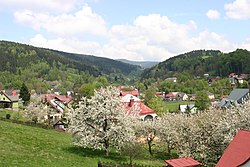Horní Maršov
Horní Maršov | |
|---|---|
 General view | |
| Coordinates: 50°39′31″N 15°49′11″E / 50.65861°N 15.81972°E | |
| Country | |
| Region | Hradec Králové |
| District | Trutnov |
| First mentioned | 1541 |
| Area | |
• Total | 28.47 km2 (10.99 sq mi) |
| Elevation | 575 m (1,886 ft) |
| Population (2024-01-01)[1] | |
• Total | 931 |
| • Density | 33/km2 (85/sq mi) |
| Time zone | UTC+1 (CET) |
| • Summer (DST) | UTC+2 (CEST) |
| Postal code | 542 26 |
| Website | hornimarsov |
Horní Maršov (German: Marschendorf) is a municipality and village in Trutnov District in the Hradec Králové Region of the Czech Republic. It has about 900 inhabitants. It lies in the Giant Mountains.
Administrative parts
[edit]The villages of Dolní Albeřice, Dolní Lysečiny, Horní Albeřice, Horní Lysečiny and Temný Důl are administrative parts of Horní Maršov.
Etymology
[edit]Both the Czech name Maršov and the German name Marschendorf means "Marš's/Marsch's village". The attribute horní means 'upper'.[2]
Geography
[edit]Horní Maršov is located about 11 kilometres (7 mi) northwest of Trutnov and 49 km (30 mi) north of Hradec Králové, on the border with Poland. It lies in the Giant Mountains. The highest point is at 550 m (1,800 ft) above sea level. Most of the municipal territory lies in the Krkonoše National Park. The Úpa River flows through the municipality.
History
[edit]The first written mention of Maršov is from 1541. A wooden church in Maršov was first documented in 1565.[3] The division of the village into Horní Maršov and Dolní Maršov (today an integral part of Svoboda nad Úpou) first appeared in 1654.[2]
During the German occupation of Czechoslovakia in World War II, the Germans established and operated the E584 forced labour subcamp of the Stalag VIII-B/344 prisoner-of-war camp in the village.[4]
Demographics
[edit]
|
|
| ||||||||||||||||||||||||||||||||||||||||||||||||||||||
| Source: Censuses[5][6] | ||||||||||||||||||||||||||||||||||||||||||||||||||||||||
Transport
[edit]There are no railways or major roads passing through the municipality.
Sights
[edit]
The main landmark of Horní Maršov is the Church of the Assumption of the Virgin Mary. It was built by Josef Schulz in the neo-Gothic style in 1895–1899.[7]
The Horní Maršov Castle belongs to the most valuable buildings of the village. It was built in the late Baroque style in 1792. In 1869, it was rebuilt in the Neo-Renaissance style and the tower was added.[8]
References
[edit]- ^ "Population of Municipalities – 1 January 2024". Czech Statistical Office. 2024-05-17.
- ^ a b Profous, Antonín (1949). Místní jména v Čechách II: CH–L (in Czech). pp. 29–30.
- ^ "Stavební dějiny fary v Horním Maršově čp. 175 na základě písemných pramenů" (in Czech). SEVER – Středisko Ekologické Výchovy a Etiky Rýchory. Retrieved 2024-02-05.
- ^ "Working Parties". lamsdorf.com. Archived from the original on 2020-10-29. Retrieved 2021-04-02.
- ^ "Historický lexikon obcí České republiky 1869–2011" (in Czech). Czech Statistical Office. 2015-12-21.
- ^ "Population Census 2021: Population by sex". Public Database. Czech Statistical Office. 2021-03-27.
- ^ "Kostel Nanebevzetí Panny Marie v Horním Maršově" (in Czech). CzechTourism. Retrieved 2022-10-03.
- ^ "Zámek" (in Czech). National Heritage Institute. Retrieved 2022-10-03.
External links
[edit]



